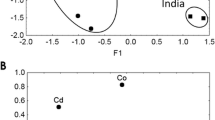Abstract
The mineral and flavonoid contents of commercially available different types of teas (premium black, flavored black, green, and fruit tea) and the infusions produced from them were determined. Studied teas differed in the contents of elements between their raw materials and infusions. Iron and copper exhibited the lowest efficiency of extraction by hot water. For the most popular black tea brand (Lipton® Yellow label) the efficiency of metal extraction decreased in the order: Co>Mn>Ni>Zn>Cu>Fe. Flavored black Citrus tea infusion had the highest content of Co and Ni, while Yellow label and Green Indonesia are a good source of Fe, Mn, and Zn. Flavonoids were predominantly present as glycosides. Rutin was present at much higher levels in black and green teas. Significant amounts of naringin and hesperidin were determined in tea infusions with citrus aromas or fruits.
Similar content being viewed by others
References
Harbowy ME, Balentine DA. Tea chemistry. Crit. Rev. Plant Sci. 16: 415–480 (1997)
Chen HY, Lin YC, Hsieh C. Evaluation of antioxidant activity of aqueous extract of some selected nutraceutical herbs. Food Chem. 104: 1418–1424 (2007)
Widlansky ME, Duffy SJ, Hamburg NM, Gokce N, Warden BA, Wiseman S, Keaney JF Jr, Frei B, Vita JA. Effects of black tea consumption on plasma catechins and markers of oxidative stress and inflammation in patients with coronary artery disease. Free Radical Bio. Med. 38: 499–506 (2005)
Sharangi AB. Medicinal and therapeutic potentialities of tea (Camelia sinensis L.) — A review. Food Res. Int. 42: 529–535 (2009)
Khan N, Mukhtan H. Tea polyphenols for health promotion. Life Sci. 81: 519–533 (2007)
Karak T, Bhagat RM. Trace elements in tea leaves, made tea and tea infusion: A review. Food Res. Int. 43: 2234–2252 (2010)
Szymczycha-Madeja A, Welna M, Pohl P. Elemental analysis of teas and their infusions by spectrometric methods. Trends Anal. Chem. 35: 165–181 (2012)
Kyle JAM, Morrice PC, McNell G, Duthie GG. Effects of infusion time and addition of milk on content and absorption of polyphenols from black tea. J. Agr. Food Chem. 55: 4889–4894 (2007)
Horzic D, Komes D, Belscak A, Ganic K, Ivekovic D, Karlovic D. The composition of polyphenols and methylxanthines in teas and herbal infusions. Food Chem. 115: 441–448 (2009)
Danrong Z, Yuqiong C, Dejiang N. Effect of water quality on the nutritional components and antioxidant activity of green tea extract. Food Chem. 113: 110–114 (2009)
Biesaga M, Pyrzynska K. Liquid chromatography/tandem mass spectrometry studies of the phenolic compounds in honey. J. Chromatogr. A 1216: 6620–6628 (2009)
Kumar A, Nair AGC, Reddy AVR, Garg AN. Availability of essential elements in Indian and US tea brands. Food Chem. 89: 441–448 (2005)
Han WY, Shi YZ, Ma LF, Ruan JY. Arsenic, cadmium, chromium, cobalt, and copper in different types of Chinese tea. B. Environ. Contam. Tox. 75: 272–277 (2005)
Seenivasan S, Manikandan N, Muraleedharan N, Selvasundaram R. Heavy metal content of black teas from south India. Food Control 19: 746–749 (2008)
Gallaher RN, Gallaher K, Marshall AJ, Marshall AC. Mineral analysis of ten types of commercially available tea. J. Food Compos. Anal. 19: S53–S57 (2006)
Nookabkaew S, Rangkadilok N, Satayavivad J. Determination of trace elements in herbal tea products and their infusions consumed in Thailand. J. Agr. Food Chem. 54: 6939–6944 (2006)
Jin CW, Zheng SJ, He YF, Zhou GD, Zhou ZX. Lead contamination in tea garden soils and factors affecting its bioavailability. Chemosphere 59: 1151–1159 (2005)
Pohl P, Prusisz B. Simple and versatile operational fractionation of Fe and Zn in dietary products by solid phase extraction on ion exchange resins. Talanta 71: 411–418 (2007)
Pêkal A, Biesaga M, Pyrzynska K. Interaction of quercetin with copper ions: Complexation, oxidation, and reactivity towards radicals. Biometals 24: 41–49 (2010)
Powell JJ, Burden TJ, Thompson RP. In vitro mineral availability from digested tea: A rich dietary source of manganese. Analyst 123: 1721–1724 (1998)
Flaten TP. Aluminum in tea — Concentrations, speciation, and bioavailability. Coordin. Chem. Rev. 228: 385–395 (2002)
Pohl P, Prusisz B. Fractionation analysis of manganese and zinc in tea infusions by two-column solid phase extraction and flame atomic absorption spectrometry. Food Chem. 102: 1415–1424 (2007)
Erdemoğlu SB, Pyrzynska K, Gucer S. Speciation of aluminum in tea infusion by ion-exchange resins and flame AAS detection. Anal. Chim. Acta 411: 81–89 (2000)
Jung UJ, Lee MK, Jeong KS, Choi MS. The hypoglycemic effects of hesperidin and naringin are partly mediated by hepatic glucoseregulating enzymes in C57BL/KsJ-db/db mice. J. Nutr. 134: 249–250 (2004)
Horcajada MN, Habauzit V, Trzeciakiewicz A, Morand C, Gil-Izquierdo A, Mardon A, Lebecque P, Davicco MJ, Chee WS, Coxam V, Offord E. Hesperidin inhibits ovariectomized-induced osteopenia and shows differential effects on bone mass and strength in young and adult intact rats. J. Appl. Phys. 104: 648–654 (2008)
Peterson J, Dwyer J, Bhagwat S, Haytowitz D, Holden J, Eldridge AL, Beecher G, Aladesanmi J. Major flavonoids in dry tea. J. Food Compos. Anal. 18: 487–501 (2005)
Author information
Authors and Affiliations
Corresponding author
Rights and permissions
About this article
Cite this article
Pękal, A., Biesaga, M. & Pyrzynska, K. Trace metals and flavonoids in different types of tea. Food Sci Biotechnol 22, 925–930 (2013). https://doi.org/10.1007/s10068-013-0165-y
Received:
Revised:
Accepted:
Published:
Issue Date:
DOI: https://doi.org/10.1007/s10068-013-0165-y



